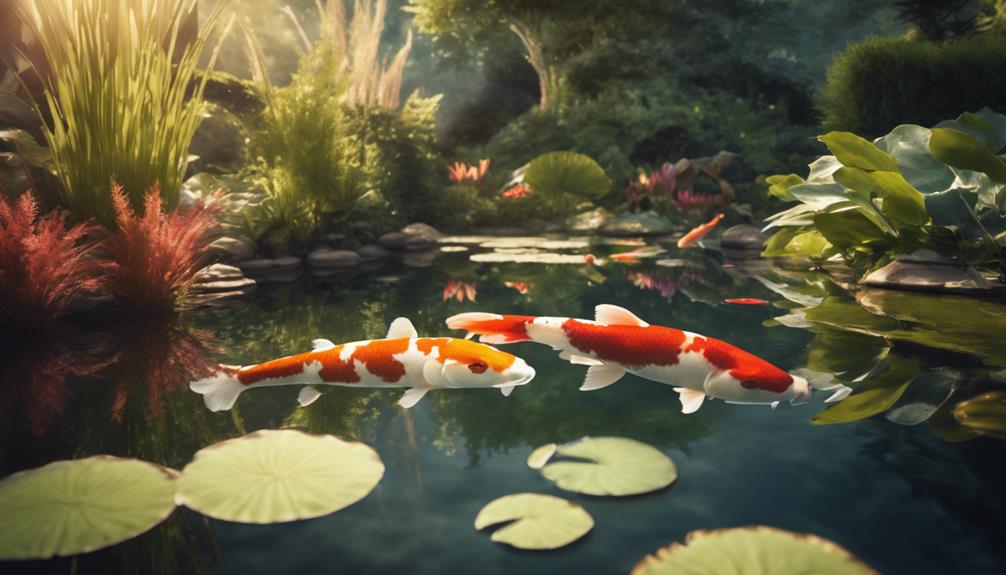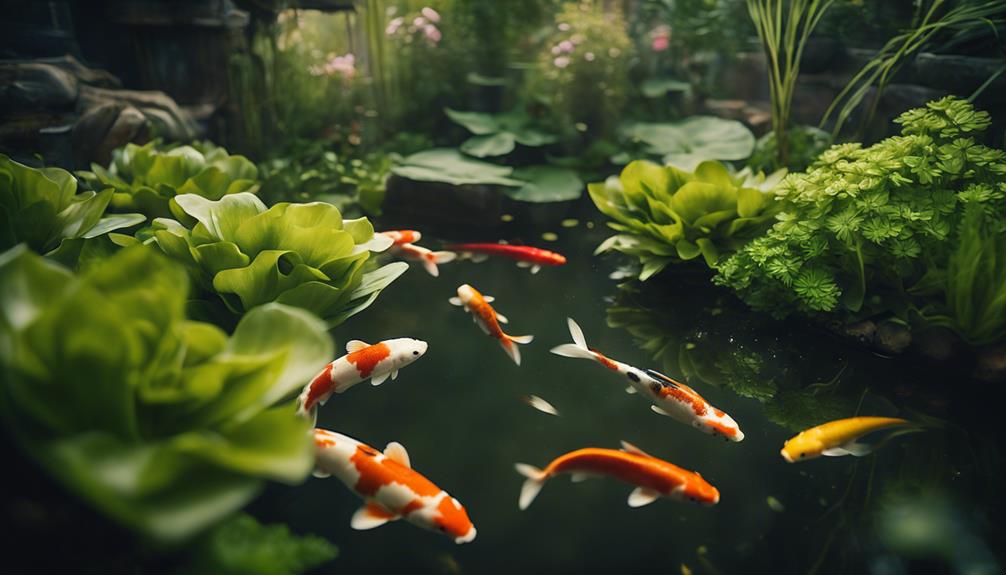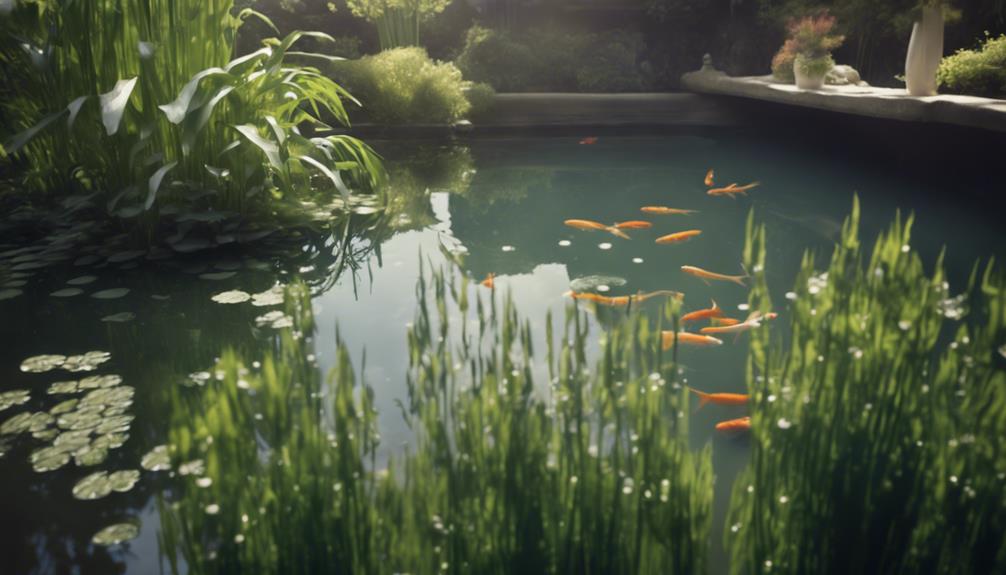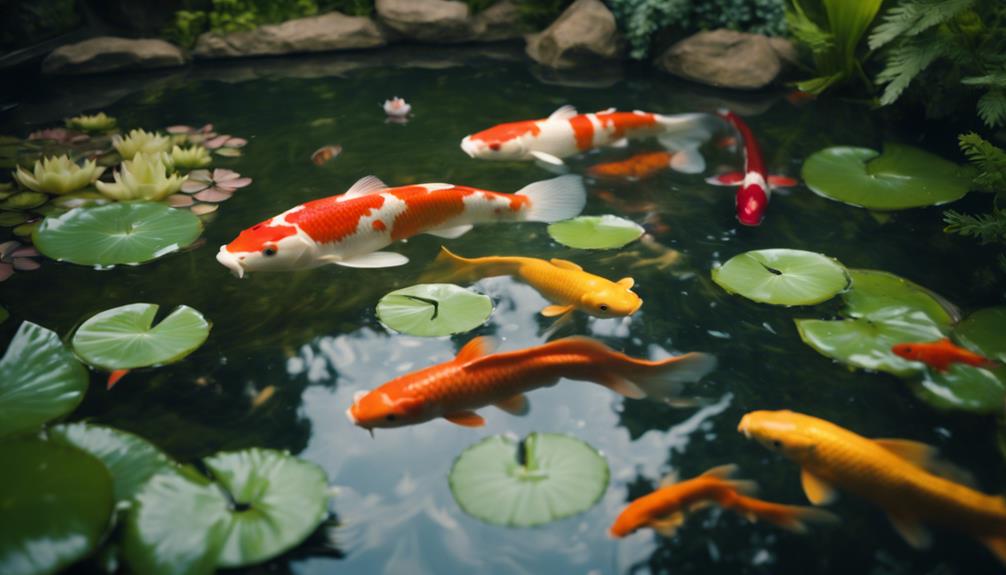When choosing aquatic plants for your koi, select a mix of marginal, submerged, and floating plants to create a balanced environment. Hardy Water Lilies, Hornwort, and Water Iris are great options, providing shade, limiting algae growth, and oxygenating the water. Consider your pond's conditions and your koi's needs when selecting plants. Be sure to avoid toxic or overly aggressive plants that can harm your fish or overrun the pond. By selecting the right plants, you'll create a thriving ecosystem that keeps your koi healthy and happy. Now, explore the specific needs of your koi and the perfect plants to meet them.
Table of Contents
Key Takeaways
- Select plants that balance koi needs with pond conditions and personal preferences for a thriving environment.
- A mix of marginal, submerged, and floating plants creates a balanced ecosystem and supports healthy koi.
- Choose plants that absorb excess nutrients, provide shade, and oxygenate the water, such as Hornwort and Water Iris.
- Avoid toxic or invasive plants that can harm koi or outcompete native plants, and prune regularly to prevent overcrowding.
- Consider water quality, sunlight, and temperature when selecting aquatic plants to ensure a harmonious ecosystem.
Best Aquatic Plants for Koi
You can choose from a variety of aquatic plants that not only add beauty to your koi pond but also provide numerous benefits for your fish, including the five top picks discussed below.
When it comes to koi pond plants, you'll want to think about those that provide shade, consume excess nutrients, and oxygenate the water.
Water Lotus, with its fragrant flowers, is a top pick, but it requires full sun and warm temperatures.
Hardy water lilies, like Water Lilies, are gorgeous and irresistible, providing shade to koi and limiting algae growth.
As a Marginal plant, Water Iris thrives in shallow water, blooming in every color of the rainbow.
Hornwort, a bushy aquatic plant, consumes excess nutrients, limits algae growth, and oxygenates the water.
These water plants will create a perfect habitat for your koi, keeping them healthy and happy.
Plants That Complement Koi
While the top aquatic plants mentioned earlier provide a solid foundation for a thriving koi pond, selecting plants that complement koi behavior and preferences can further enhance their living environment. You want to choose plants that provide shade, keep the water clean, and reduce algae growth. Koi appreciate having areas to hide and rest, so incorporating emergent plants like cattails or bulrushes can create a sense of security.
Here are some aquatic plants that complement koi:
| Plant | Benefits | Growth Habit |
|---|---|---|
| Water Wisteria | Provides shade, reduces algae | Submerged, 6-10 ft |
| Hornwort | Keeps water clean, provides hiding spots | Submerged, 1-3 ft |
| Cattails | Emergent, provides shade and hiding spots | Emergent, 3-6 ft |
| Anacharis | Reduces algae, provides food source | Submerged, 1-3 ft |
| Water Hyacinth | Provides shade, reduces algae | Floating, 1-3 ft |
Choosing the Right Plants

Selecting the right aquatic plants for your koi pond involves balancing their specific needs with the pond's unique conditions and your personal preferences.
As a koi pond owner, you want to create a thriving ecosystem that benefits both your fish and the environment.
The right aquatic plants won't only enhance the aesthetic appeal of your pond but also improve water quality.
You'll want to choose a mix of marginal, submerged, and floating plants to create a balanced environment.
Marginal plants, like cattails and rushes, thrive in shallow water and help filter out pollutants.
Submerged plants, such as anacharis and cabomba, absorb excess nutrients and provide shelter for your koi.
Floating plants, like water lettuce and water hyacinth, shade the water and reduce algae growth.
By incorporating these plants, you'll create a self-sustaining ecosystem where your koi can thrive.
Plants to Avoid for Koi
When selecting aquatic plants for your koi pond, you must be aware of the species that can harm your fish or create maintenance issues.
You'll want to avoid plants that are toxic to koi fish or exhibit overly aggressive growth habits, as they can outcompete native species and create an imbalance in your pond's ecosystem.
Toxic to Koi Fish
Can you identify the aquatic plants that could be silently killing your koi fish, as some species can release toxic compounds into the water?
As a responsible koi pond owner, it's vital to avoid plants that can harm your beloved fish. Water Iris, for instance, may oxygenate the water, but its rhizomes contain toxic compounds that can be detrimental to koi health.
Similarly, Lotus and Water Poppy, although aesthetically pleasing, can release toxic substances that can poison your fish.
On the other hand, koi love plants like Hornwort, which provide them with a natural snack and habitat.
However, some plants, like Water Iris, have roots that koi love to eat, but these roots can be toxic to them.
It's imperative to research and understand the plants you introduce to your koi pond to safeguard they're safe for your fish.
Avoid plants that can release toxic compounds, and instead, opt for non-toxic, oxygenating plants that promote a healthy environment for your koi.
Overly Aggressive Growers
You'll want to steer clear of overly aggressive growers that can quickly overrun your koi pond, causing more harm than good.
Plants like Curly-leaf pondweed, Phragmites, Naiad, Cabomba, and Hydrilla are all culprits that can wreak havoc on your pond's ecosystem.
These invasive species can reduce oxygen levels, trap sediments, outcompete native plants, and even clog waterways.
Instead, opt for plants that provide benefits without becoming too dominant.
Water Iris and dwarf lotus varieties can add beauty to your pond while providing shade and helping to keep the water cool.
Water Lettuce and Hornwort are also great options, as they help control algae growth and provide a natural food source for your koi.
Lotus and Water lily are also suitable choices, as they help regulate the water's temperature and provide a habitat for your fish.
By choosing the right plants, you can create a thriving environment for your koi to flourish.
Caring for Aquatic Plants

By incorporating a regular maintenance routine, you can effectively care for your aquatic plants, promoting their prosperity and contribution to a healthy koi pond ecosystem.
Regular pruning of your aquatic plants is essential, as it helps maintain their shape, promotes healthy growth, and prevents overcrowding, which can lead to reduced oxygen levels and increased algae growth.
Fertilizing your aquatic plants with specialized aquatic plant fertilizers provides them with essential nutrients, promoting their growth and ability to absorb excess nutrients that can contribute to algae blooms.
It's also imperative to monitor water quality and make adjustments as necessary to establish ideal conditions for your aquatic plants.
Providing adequate sunlight, at least 4-6 hours of direct sunlight per day, is necessary for photosynthesis and healthy growth.
To prevent competition with your aquatic plants, control algae growth by maintaining good water circulation, monitoring nutrient levels, and introducing algae-controlling plants.
Benefits of Aquatic Plants
Your aquatic plants play a vital role in maintaining a balanced ecosystem in your koi pond, providing numerous benefits that ultimately enhance the health and well-being of your fish.
By absorbing excess nutrients, plants help filter the water, keeping it clean and clear. This, in turn, prevents algae growth, which can be detrimental to your koi's health.
Additionally, aquatic plants oxygenate the water, essential for the survival of your fish. They also provide shelter, giving your koi a sense of security and reducing stress.
This habitat also attracts other pond creatures, such as insects and birds, creating a thriving ecosystem. By incorporating aquatic plants into your pond, you're not only beautifying the space but also creating a natural environment that mimics their wild counterparts.
Your plants and water work together in harmony, ensuring a healthy and thriving environment for your koi to flourish.
Creating a Balanced Ecosystem

As you design your koi pond's ecosystem, you'll need to take into account several key factors to achieve balance.
You'll want to manage nutrient cycles, control water quality, and maintain a delicate harmony among these elements.
Ecosystem Balance Factors
You must carefully consider several key ecosystem balance factors when creating a thriving environment for your koi, including water quality, nutrient availability, and aquatic plant selection.
In a pond's ecosystem, water temperatures can greatly impact the health of your koi. For instance, sudden changes can lead to stress, making them more susceptible to disease. An algae bloom can also deplete oxygen levels, putting your koi at risk.
To combat this, you'll need to manage debris and excess nutrients that can fuel algae growth. Strategically placing aquatic plants around the pond's edge can provide shade, reducing the likelihood of an algae bloom. By doing so, you'll create an environment where your koi can stay healthy and thrive.
Maintaining healthy water conditions is crucial to support a balanced ecosystem. Regularly monitor water temperatures, oxygen levels, and nutrient availability to support a thriving environment for your koi.
Nutrient Cycle Management
Effective nutrient cycle management involves strategically selecting and placing aquatic plants that absorb excess nutrients, thereby preventing algae growth and maintaining a balanced ecosystem.
As you choose your aquatic plants, consider those that excel at nutrient uptake, such as Hornwort and Submerged plants. These plants help keep the water clean by absorbing excess nutrients, which in turn prevents algae growth.
This approach not only maintains a balanced ecosystem but also reduces pond maintenance tasks. By incorporating plants that thrive in your pond's conditions, you create a natural filter system that benefits your koi.
For example, water Iris plants add beauty and functionality to your pond, while also helping to regulate nutrient levels. By understanding how aquatic plants impact the nutrient cycle, you can create a thriving environment for your koi.
Water Quality Control
By integrating aquatic plants into your koi pond, you're taking a key step towards creating a balanced ecosystem where water quality control is optimized.
Aquatic plants play a fundamental role in maintaining excellent water quality by absorbing excess nutrients, reducing algae growth, and providing shade. As a responsible koi keeper, you'll want to choose plants that thrive in your pond's conditions.
The Water Iris, a popular marginal plant, is an excellent choice for water quality control. Its extensive root system helps to absorb excess nutrients, preventing them from fueling algae growth.
Hornwort, a submerged aquatic plant, is another great option. It's highly effective at removing excess nutrients and heavy metals from the water, promoting a healthy environment for your koi.
Lotus, a floating aquatic plant, provides shade, reducing the water temperature and preventing algae blooms.
Frequently Asked Questions
What Water Plants Are Good for Koi Fish?
When selecting water plants for your koi, you'll want to prioritize Oxygen Providers like Hornwort and Cabomba, Algae Controllers like Water Wisteria, and Nitrate Reducers like Anacharis, while also incorporating Pond Decor like Water Lilies and Floating Plants.
How Many Plants Should I Have in My Koi Pond?
"How many plants do you need to create a thriving ecosystem? Consider your pond's size, water volume, and desired aesthetic balance. Aim for 20-30% coverage, with 2-3 types for small ponds, 4-6 for medium, and 6-8 for large ones, ensuring spatial distribution for aquatic harmony."
What Plants Will Koi Fish Not Eat?
You're looking for koi-resistant plants that'll thrive in your pond without becoming fish food. Opt for Water Lilies, Water Lotus, or Sweet Flag, which are often fish-ignored and provide pond ornamentals while ensuring plant safety.
Do I Need Plants in My Koi Pond?
You need plants in your koi pond to maintain ecosystem balance, support habitat creation, and act as a biological filter, which improves water quality, enhances pond aesthetics, and provides natural shelter with visual hiding, reducing pond maintenance and environmental impact.
Conclusion
As you finalize your aquatic plant selection, remember that a balanced ecosystem is key to a thriving koi habitat.
Aquatic plants can absorb up to 75% of excess nutrients from the water, substantially reducing algae growth and maintaining water quality.
By choosing the right plants, you'll create a harmonious environment where your koi can flourish.

